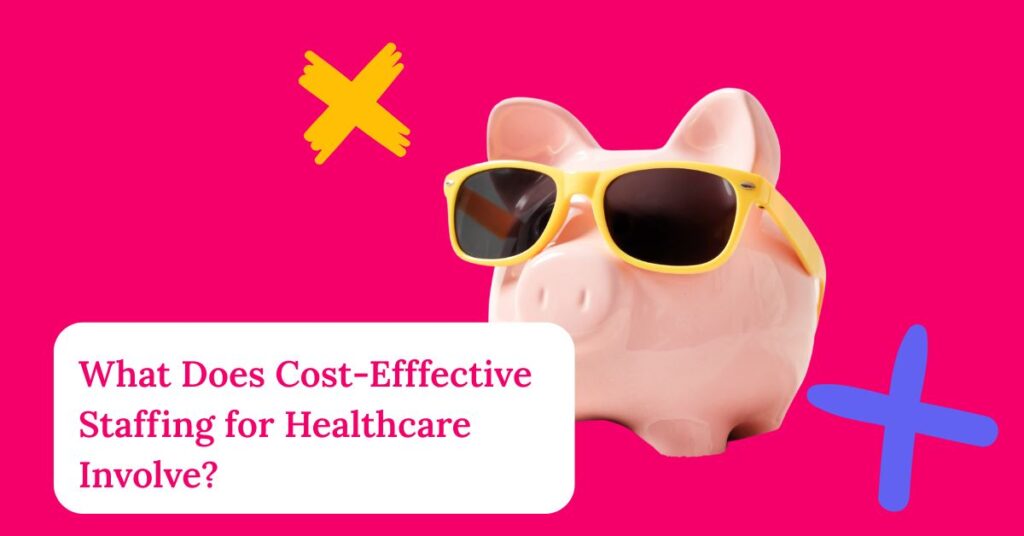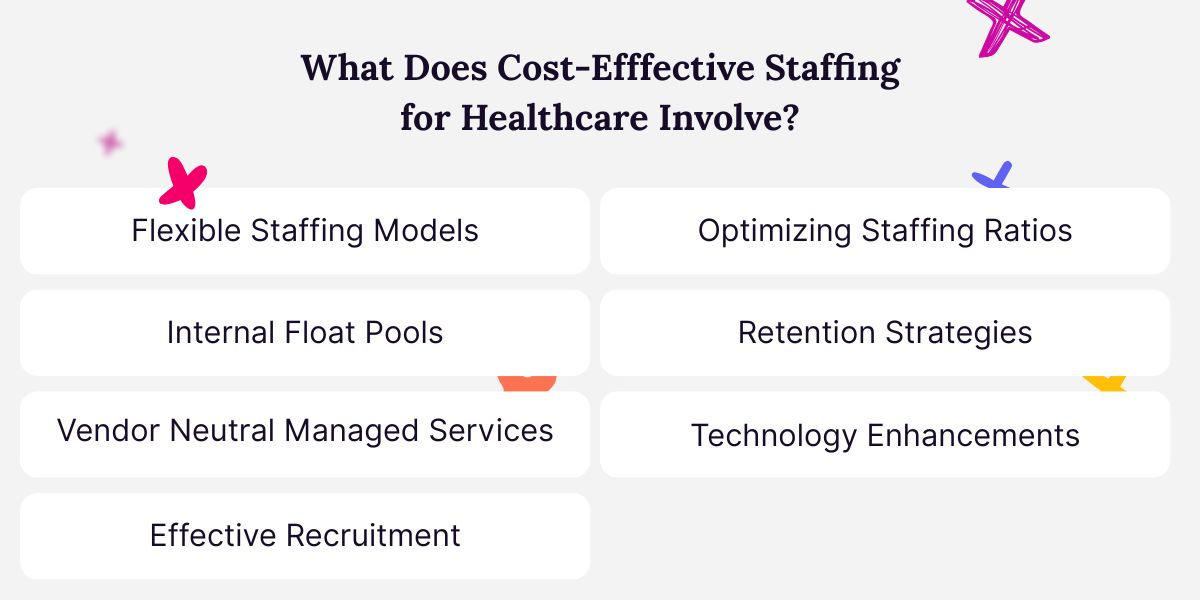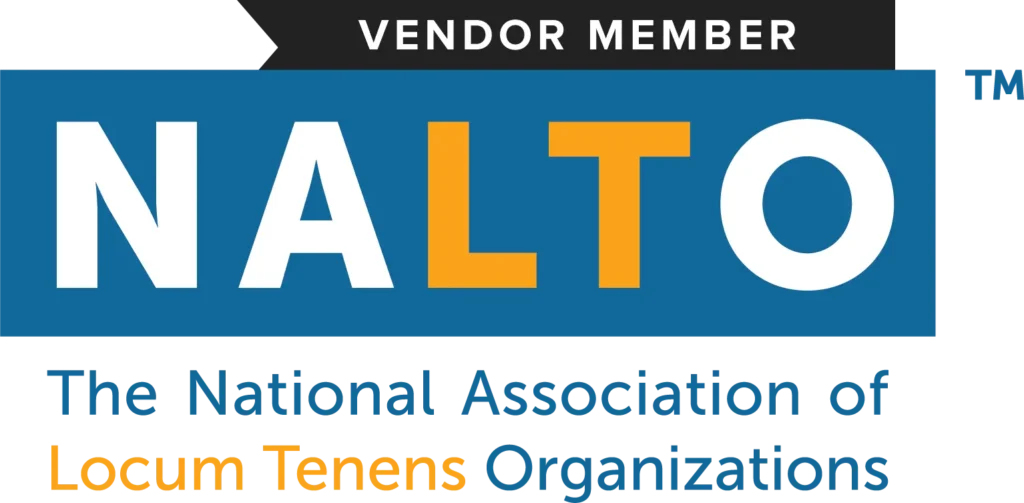
What Does Cost-Effective Staffing for Healthcare Involve?
Healthcare organizations today face a critical balancing act between delivering high-quality patient care and managing unpredictable staffing gaps (that lead to higher labor costs). The solution lies in a strategic approach that combines flexible workforce models, data-driven decision-making, and the right technology to optimize staffing efficiency. From leveraging locum tenens providers to implementing vendor-neutral managed services and float pool optimization software, cost-effective staffing is about filling shifts sustainably, and without compromising care standards.
In this article, we’ll explore how healthcare systems can reduce reliance on expensive agency staffing, improve retention, and harness advanced workforce management tools to maintain the ideal balance between cost and quality. Whether you’re a hospital administrator, a clinic manager, or a healthcare executive, understanding these key components can help you build a more resilient, financially sustainable staffing strategy. Let’s get started.
Flexible Staffing Models
Flexible staffing models are dynamic workforce strategies designed to adapt to fluctuating patient volumes, seasonal demands, and unexpected staffing shortages in healthcare. These models prioritize agility, often incorporating locum tenens providers, per-diem staff, and internal float pools to ensure continuity of care without the long-term financial burden of full-time hires.
By leveraging vendor management systems (VMS) and workforce optimization software, healthcare organizations can efficiently match temporary or supplemental clinicians with shifts, reducing reliance on costly agency staffing while maintaining high-quality care. The result is a scalable, cost-effective approach that balances operational efficiency with the ability to respond swiftly to changing needs.
Managed service providers (MSPs) enhance this flexibility by streamlining the locum tenens process through advanced vendor management system (VMS) software. These platforms automate credentialing, scheduling, and compliance tracking, reducing administrative burdens and ensuring rapid placement of qualified providers. By leveraging data-driven insights, healthcare organizations can optimize staffing levels, minimize overtime costs, and reduce reliance on expensive agency contracts.

Internal Float Pools
An internal float pool serves as a sustainable alternative to external staffing agencies, offering health systems greater control over costs and quality. Internal float pools provide an opportunity for hospitals to create their own pool of locum tenens providers—including physicians and advanced practice providers—without needing to rely exclusively on agencies. These pools provide on-demand coverage for fluctuating needs across multiple departments, often at better rates than traditional locums staffing.
To maximize efficiency, leading healthcare organizations utilize float pool management software. This technology centralizes scheduling, tracks provider availability, and forecasts staffing gaps based on historical trends. By integrating with broader workforce management systems, these tools ensure that internal resources are deployed strategically, reducing dependency on external locum tenens while maintaining flexibility.
When internal pools are insufficient, a hybrid approach—supplementing with vetted locum tenens through a MSP—ensures seamless patient care without compromising fiscal responsibility.
Vendor Neutral Managed Services
In an industry where staffing needs vary by specialty, location, and urgency, vendor-neutral managed services provide healthcare systems with an unbiased, centralized approach to workforce management. Unlike traditional staffing agencies that may prioritize their own roster, a vendor-neutral managed service provider (MSP) leverages a broad network of vetted locum tenens professionals and agencies, ensuring the best match for cost, quality, and availability.
Integrated VMS software plays a pivotal role, automating procurement, credentialing, and billing while offering real-time analytics to track spending and performance. This transparency eliminates favoritism, reduces administrative overhead, and empowers healthcare organizations to make data-driven staffing decisions.
Effective Recruitment
Securing top-tier locum tenens providers requires a strategic, technology-enhanced recruitment process. Advanced staffing platforms streamline candidate sourcing by aggregating profiles from multiple agencies, applying AI-driven matching to align provider skills with facility needs, and automating compliance checks to accelerate onboarding.
For internal float pools, recruitment software helps identify and engage clinicians who already understand the organization’s workflows, reducing orientation time and improving retention. By combining intelligent software with deep industry expertise, managed service providers ensure that healthcare facilities minimize turnover costs while maintaining a pipeline of reliable, high-quality temporary and permanent-flex staff.
Optimizing Staffing Ratios
Maintaining the ideal balance between patient needs and clinician availability is critical for both care quality and financial sustainability. Understaffing leads to burnout and compromised outcomes, while overstaffing drains resources unnecessarily. Locum tenens providers offer a strategic solution, allowing facilities to scale their workforce up or down in response to census fluctuations, seasonal spikes, or unexpected absences, but it can be a challenge to predict when you’ll need them.
Enter workforce management software, which can analyze historical trends, predicting demand surges, and recommending optimal staffing mixes. By dynamically adjusting ratios without over-relying on costly overtime or agency premiums, healthcare organizations can achieve both clinical and fiscal efficiency.

Retention Strategies
While temporary staff address immediate gaps, long-term cost-effectiveness hinges on retaining core team members. Excessive turnover disrupts care continuity and inflates recruitment costs. A dual approach that fosters a supportive environment for permanent staff while integrating locum tenens seamlessly can alleviate pressure. Float pool software helps by equitably distributing shifts and preventing burnout among full-time clinicians. Meanwhile, MSPs contribute by providing high-quality locum tenens who align culturally and clinically with the organization, reducing friction during transitions.
Recognition programs, competitive compensation, and predictive analytics (like identifying attrition risks early) further solidify retention. When temporary and permanent staff collaborate effectively, turnover declines, and the overall workforce becomes more resilient.
Technology Enhancements
The backbone of modern cost-effective staffing lies in technology that unifies visibility, automation, and decision-making. Vendor management systems (VMS) centralize locum tenens procurement, tracking everything from credential expirations to shift fulfillment rates, while AI-driven tools match providers to openings based on specialty, location, and past performance metrics.
For internal pools, scheduling software optimizes shift fills by notifying available clinicians in real time and forecasting gaps before they become crises. Interoperability with EHRs and payroll systems further reduces manual errors and delays. These advancements turn staffing from a reactive expense into a strategic asset, where data illuminates the most efficient paths to quality care.
Cost-Effective Healthcare Staffing Starts Here
Syncx empowers healthcare organizations to optimize their workforce through a seamless integration of vendor-neutral locum tenens solutions, advanced float pool management, and data-driven VMS software. Whether you’re looking to reduce agency spend, streamline internal staffing, or gain real-time visibility into your workforce, our platform delivers the tools to transform staffing from a challenge into a competitive advantage.
Ready to see how it works? Schedule a demo today and discover how Syncx can tailor cost-effective staffing solutions to your organization’s unique needs.




